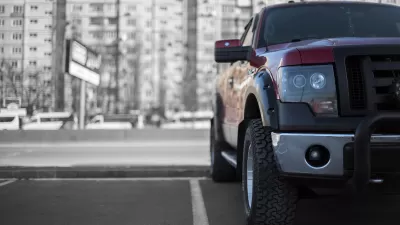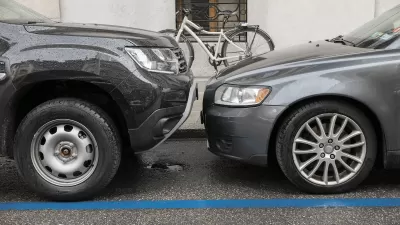A new study shows that modern safety features are more important than size and weight once vehicles weigh over 4,000 pounds.

The “bigger is safer” argument for large trucks and SUVs has reached a plateau, according to an analysis from the Insurance Institute for Highway Safety, which reveals that vehicles over 4,000 pounds don’t offer any significant safety benefits over lighter vehicles. For context, the average American car weighs 4,100 pounds, notes Kea Wilson in Streetsblog USA.
Although vehicle size and weight did, for a while, make a difference for safety, Wilson explains, “advances in other vehicle safety strategies like better front-end design and automatic emergency braking have increased the "crash compatibility" of average-sized vehicles, making the occupants of those cars more likely to survive being hit by the driver of a monster truck — though not necessarily sparing the lives of people outside cars when those drivers strike them.”
Meanwhile, safety continues to decrease for pedestrians and other people outside of the vehicles as vehicles get larger. Taller vehicles are more likely to strike people in the head or vital organs, while large cars and front ends can also obscure drivers’ visibility and perception of speed.
While Wilson acknowledges that “ regulators under President Trump are unlikely to mandate new safety updates to protect vulnerable road users,” many automakers are already voluntarily implementing changes, but pedestrian safety doesn’t always rank at the top of the upgrades list.
FULL STORY: Study: You’re Not That Much Safer In a 4,000+ Pound Car

Study: Maui’s Plan to Convert Vacation Rentals to Long-Term Housing Could Cause Nearly $1 Billion Economic Loss
The plan would reduce visitor accommodation by 25,% resulting in 1,900 jobs lost.

North Texas Transit Leaders Tout Benefits of TOD for Growing Region
At a summit focused on transit-oriented development, policymakers discussed how North Texas’ expanded light rail system can serve as a tool for economic growth.

Using Old Oil and Gas Wells for Green Energy Storage
Penn State researchers have found that repurposing abandoned oil and gas wells for geothermal-assisted compressed-air energy storage can boost efficiency, reduce environmental risks, and support clean energy and job transitions.

Santa Barbara Could Build Housing on County Land
County supervisors moved forward a proposal to build workforce housing on two county-owned parcels.

San Mateo Formally Opposes Freeway Project
The city council will send a letter to Caltrans urging the agency to reconsider a plan to expand the 101 through the city of San Mateo.

A Bronx Community Fights to Have its Voice Heard
After organizing and giving input for decades, the community around the Kingsbridge Armory might actually see it redeveloped — and they want to continue to have a say in how it goes.
Urban Design for Planners 1: Software Tools
This six-course series explores essential urban design concepts using open source software and equips planners with the tools they need to participate fully in the urban design process.
Planning for Universal Design
Learn the tools for implementing Universal Design in planning regulations.
Ascent Environmental
Borough of Carlisle
Institute for Housing and Urban Development Studies (IHS)
City of Grandview
Harvard GSD Executive Education
Toledo-Lucas County Plan Commissions
Salt Lake City
NYU Wagner Graduate School of Public Service





























